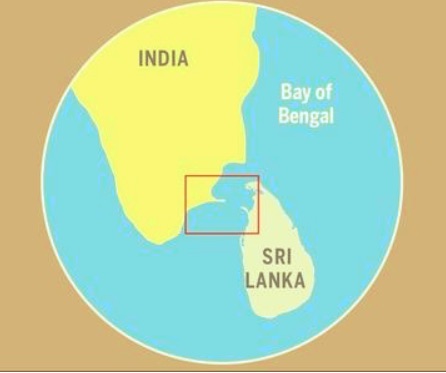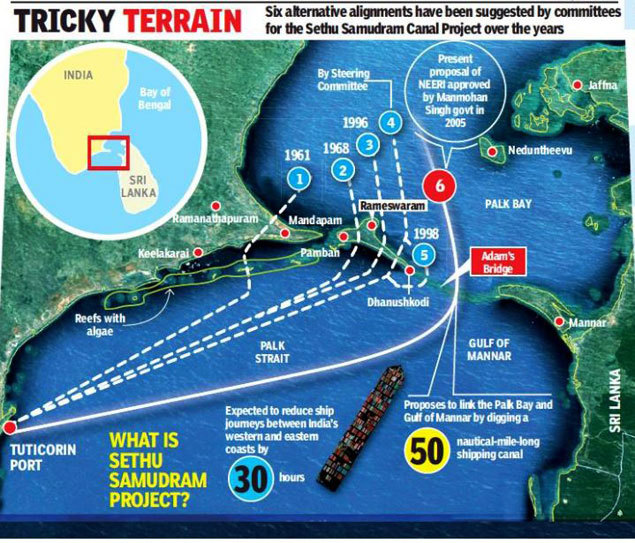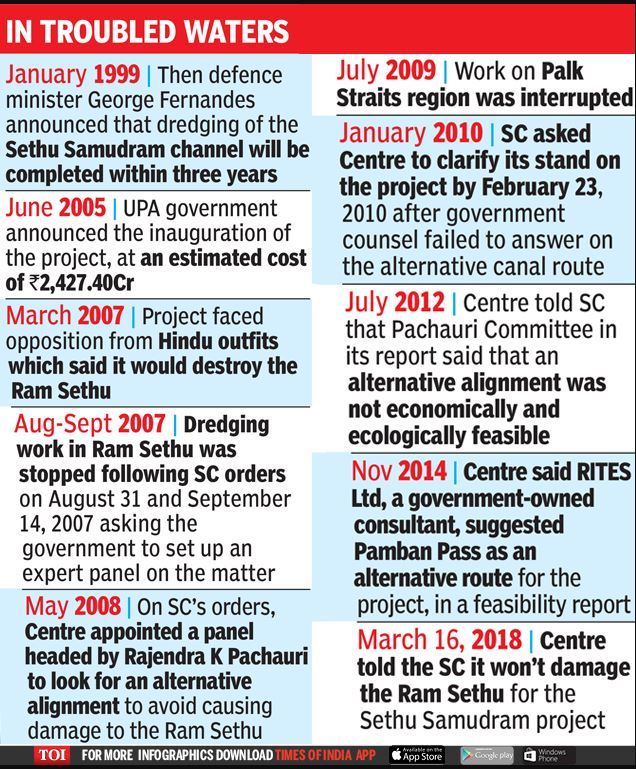Sethu Samudram Canal Project
This is a collection of articles archived for the excellence of their content. |
A brief history- 1860-2005

From: RS Vasan, Time to drop Sethu Samudram idea and rebuild ‘Ram Sethu’, April 4, 2018: The Times of India

From: RS Vasan, Time to drop Sethu Samudram idea and rebuild ‘Ram Sethu’, April 4, 2018: The Times of India

From: RS Vasan, Time to drop Sethu Samudram idea and rebuild ‘Ram Sethu’, April 4, 2018: The Times of India
HIGHLIGHTS
Sethu Samudram Canal Project was first mooted in 1860 when the British were looking to dredge the shallow straits between India and Sri Lanka to connect the Palk Strait with the Gulf of Mannar.
The canal which is proposed to stretch for some 84 km was to cut through the Ram Sethu (Adam’s Bridge).
Sethu Samudram Canal Project (SSCP) seems to be a one-of-its kind. No other project would have sustained the interest of policy makers, the public and other stakeholders for more than 150 years with nothing happening on the ground.
It was first mooted in 1860 when the British were looking to dredge the shallow straits between India and Sri Lanka to connect the Palk Strait with the Gulf of Mannar (now a marine bio-reserve). The canal which is proposed to stretch for some 84km was to cut through the Rama Sethu (Adam’s Bridge). This was first conceived of in 1860 by A D Taylor, a naval officer who was instrumental in setting up the Marine Survey of India in 1875.
In 1955, a committee headed by Ramaswamy Mudaliyar found the project both feasible and viable though it felt the land bridge would overcome the dangers of shifting sand banks and navigation. Barring sporadic attention, despite five different committee reports examining the issue of alignment, nothing much happened on the ground till the formal inauguration of the project in July 2005 by then Prime Minister Manmohan Singh.
After spending substantial amount on dredging in the area, however, there was public outrage about the possible damage to Rama Sethu which is revered by many Hindus. The UPA government appointed a six-member committee headed by Rajendra Pachauri which vindicated the apprehensions about the negative fallout of the project both in economic and environmental aspects. The Centre, however, rejected the report and went ahead with the implementation, and the Supreme Court intervened.
Not much work is being carried out and there are serious concerns about the project taking off in the current form. Even if the dredged canal is completed with new alignments, it would take ships of just under 30,000 tons and would be way below the present mega ships that carry four times that capacity to service modernised ports around the world. There are also issues related to safe navigation through the SSCP which would need to be carried out by professional navigators. The speed through the passage would be restricted and the risk of collision or grounding that would result in oil/ toxic waste spillage would impact the fragile marine environment for decades. Tamil Nadu’s fishermen are already facing a bleak future in terms of dwindling fish stock in the Palk Straits and conflict with their counterparts across the straits. The marine traffic close to the marine biosphere of the Gulf of Mannar would pose additional danger to the biodiversity. The religious sentiments of the Hindus is another factor that would hinder any efforts to resurrect the project.
If trade is the priority, here is an opportunity that needs to be grabbed with both hands. Even in 1955 when the Mudaliar committee finalised its report, it had indicated a preference to a land bridge. Ranil Wikramsinghe the present Prime Minister of Sri Lanka mooted the idea in 2000 and strongly recommended a land bridge to connect Rameswaram with Talaimannar in Sri Lanka. There has been dialogue between the two sides at the ministerial level and it was also part of the discussion between US and Sri Lanka when efforts to have an Indo-Pacific Economic Corridor were initiated. The funding for the project estimated to be about $5 billion is expected to come from Asian Development Bank. The appeal by Wikramsinghe for Japan, India and the west to increase the level of economic engagement comes in the light of Chinese debt-ridden Sri Lankan economy.
Managing the movement of goods and traffic to and fro, however, should not be such a big issue as long as proper mechanisms are in place to control, regulate and monitor the movement across the bridge once constructed. Though the Centre in an affidavit to the Supreme Court on March 16 indicated that it is examining alternative options to keep clear of the Rama Sethu, it is clear the future lies in a land bridge that will also aid the ambitious security and growth for all in the region.